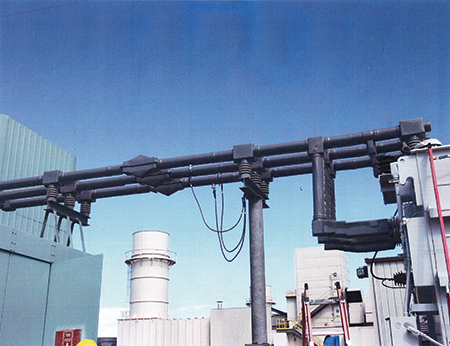The transmission and distribution of electrical energy is a vital service that is required in order to keep our modern world moving in a way that we have become accustomed. Highways need to be lit up at night, businesses have to operate without interruption and essential services such as water treatment plants and hospitals must be able to handle the stresses of this ever evolving world, all of which require a steady and reliable supply of electricity. The system that supplies the electricity that we have come to take for granted is inherently vulnerable to interruption, which can cause outages. As the networks have become more complex and extensive to keep up with demand, more hardware has been installed particularly in overhead configurations. This can translate into an increased risk of animal related outages unless appropriate precautions are put into place to prevent such occurrences. Animal induced faults on transmission and distribution systems have long been a problem and records show that they have plagued engineers both in frequency and severity. Problems such as these do not disappear on their own and, in fact, statistics show that animal-related outages are becoming more and more prevalent. Aside from the obvious concerns about the reliability of the systems, such faults significantly escalate the equipment and maintenance costs associated with unplanned outages.
Terminations, conductors, busbars, and various other components in outdoor electrical transmission and distribution systems such as substations provide excellent climbing apparatus for wildlife that is naturally inclined to seek higher ground from predators or are in search of food, the consequences of which can be the interruption of electrical supply to customers, along with extensive and expensive damage to equipment. These problems are not solely confined to remote stations out in the country but are equally prevalent in suburban and urban locations as well. The vast majority of animal-related outages occur primarily at standoff insulators associated with buswork, the bushings of transformers, circuit breakers and capacitors. The studies on animal-related outages show that equipment in the voltage range of 5kV to 38kV is the most susceptible to such occurrences. This is because electrical clearances in this voltage range can be easily spanned by animals such as squirrels, raccoons, birds and the like, with the resulting damage to equipment becoming extensive and costly. A transformer bushing that is beyond repair and requires replacement is a typical example of serious damage caused by animals in transmission and distribution systems. Similarly, a damaged pothead, which needs to be replaced, creates an expensive supply interruption due to the required rejointing of the cable. Consider an animal initiated flashover on, say, the 15kV secondary side of a main transformer. The porcelain skirts of the bushing could be damaged to the extent that the entire bushing must be disconnected and replaced, this necessitates the dropping of the oil level in the transformer for removal of the bushing. The material, labour and downtime costs associated with such an occurrence can be extremely high.
The solution to animal-related outage problems
Having recognized that it is impossible to prevent animals by land or by air from climbing or perching on outdoor electrical equipment, the installation of insulated cover up is the first logical step in combatting the problems incurred by animal invasion of the system. Available today are form-fitting reusable insulating boots in an extensive range of configurations to cover every conceivable type of termination and connection associated with transformers, circuit breakers, capacitors and busbar systems. This comprehensive range of boots provides the ability to completely encapsulate any and all complex arrangements of busbars and terminations, preventing animals from damaging the system as all of the live surfaces are no longer exposed. Throughout the electrical distribution network, there is an increasing use of automatic reclosers. These are installed in strategic positions to enhance the network reliability by reducing transient electricity supply interruptions caused by lightning and storms. These devices are typically pole-mounted and their principle function is to maintain the continuity of supply. They are compact in design and are constructed with their bushings in close proximity to each other. This makes the device particularly vulnerable to animals spanning the gaps between the bushings, making simultaneous contact and causing interruption, here again, insulated cover up boots are necessary on the terminations to maintain the complete integrity of the installation.

Transformer station with reusable insulating boots encapsulating the 13.8kV
transformer bushing terminations, busbar, busbar supports, and expansion joints
The insulating boots used in transmission and distribution systems must retain electrical integrity throughout their lifetime and from a practical point of view, they must be easily fitted and removed for maintenance procedures. The material must be formulated to withstand a wide range of climate conditions including exposure to extremely hot and cold environments, moisture and dryness, direct ultraviolet light and must also be inherently flame retardant. For these reasons the ideal cover up is form-fitting and needs to be manufactured from high-grade flexible insulation material to match the system voltage requirements.
The tolerance for loss of power supply by electrical utility customers has become less over recent years and will continue to do so as the world relies more and more on electricity for common day to day activities. Consumers are insisting upon zero interruption of supply and are calling for the appropriate guarantees of continuity. Investigations show that the supply authorities who have invested in animal control programs by encapsulating the vulnerable areas of their systems with boots can meet the demands of their customers and additionally, they are enjoying the benefit in the reduction of animal induced outages and equipment failures.
About the Author
Bernard Summerville, C.Eng. MIET. is the President of Phoenix Manufacturing Ltd. and is a member of the Institution of Engineering Technology. He has held senior management positions in the Electrical Industry in the UK and Canada and he can be reached by Email at: sales@phnxmfg.com







